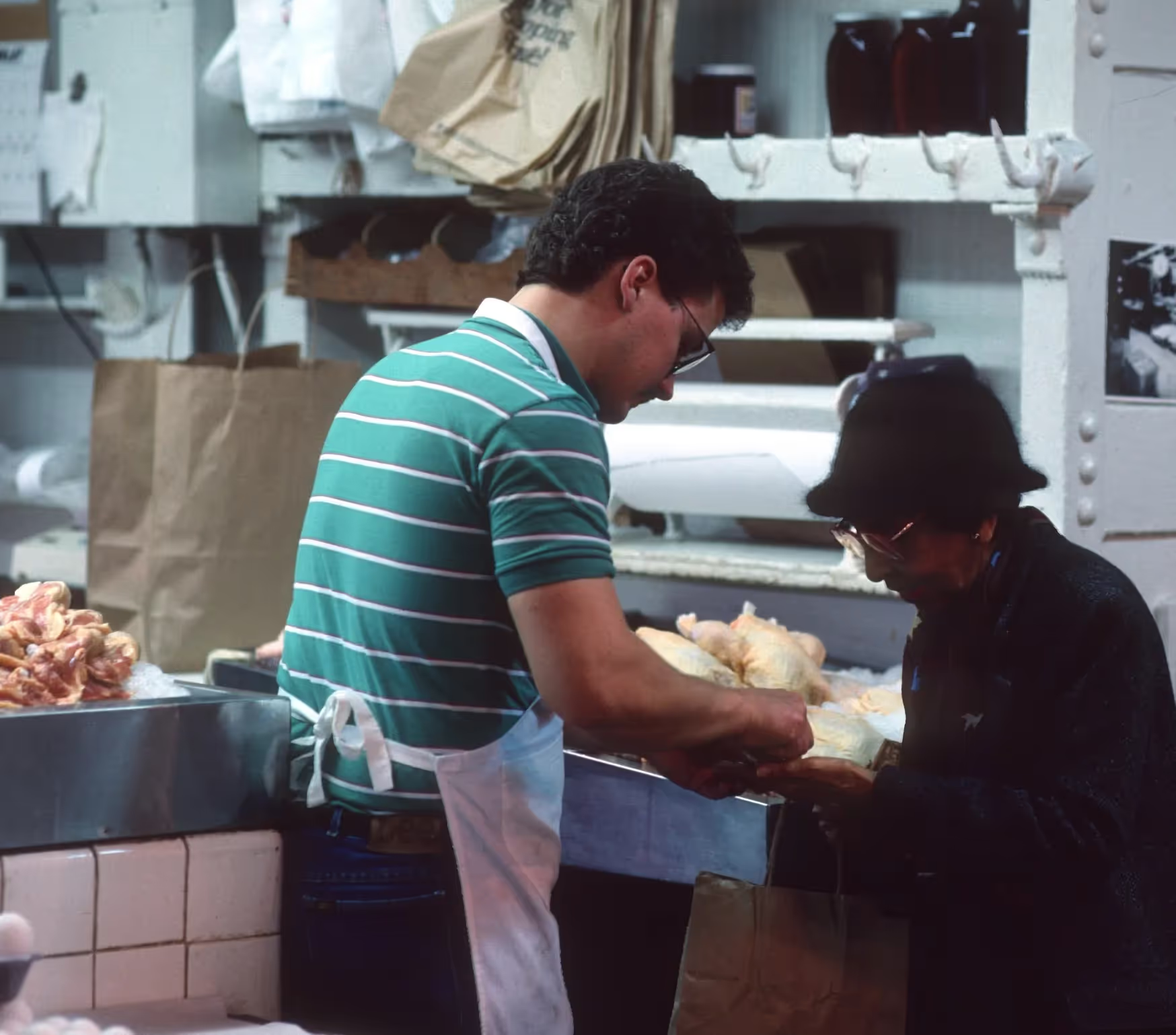A biweekly newsletter with public space news, resources, and opportunities.
A curated dispatch on all things public markets plus the latest announcements from the Market Cities Program.
Editor’s note: Learn the brass tacks of running a successful market at our upcoming training "How to Create Successful Markets” October 24 - November 9, 2023, where guest speaker David K. O’Neil will go in-depth into all things related to financial sustainability.

All over the world, there are public markets that are doing just fine. They’re offering food and goods, a place for people to gather, and employment opportunities for locals. And yet, these same markets may not be making enough money to cover operating costs—why is that?
International Market Consultant David K. O’ Neil, who started his career managing Philadelphia’s Reading Terminal Market, has some answers. Having worked for over 40 years with markets all over the world, he proposes a few ways to turn a perfectly good market into an extraordinary one with staying power. In this interview, David makes the case for taking market managers out of the office and onto the market floor.
Priscilla Posada (PP): How did you first get into the market business?
David K. O’Neil (DO): I started my career as an archaeologist and I remember that when I was in Belgrade, Serbia, I visited the market every week and bought everything I needed there. When I got back to Philadelphia, I started writing a book on the side about a murder mystery. I went to our old historic market, the Reading Terminal Market, and got a job. It was supposed to be just for one day at one of the stalls to gather dialogue for my book. It so happened that around this time, the company that owned Reading Terminal Market was getting out of bankruptcy and they were going to get the market back. It had been sublet to a slumlord, and had languished as a result—not many people went there.

I started talking to one of the guys who worked for this company. That following Monday, he offered me a job on the spot—not running the market but trying to get new vendors to move in. So I started doing that. And then, they asked me to become the manager since they didn’t have one. I worked from the bottom up. I didn’t realize back then but there’s just something about a market that makes it easy to meet people. It’s been shown to be true over and over again.
PP: When you were managing Reading Terminal, what were some key decisions that led to the market turning around and becoming the success that it is today?
DO: There were a few things. For one, the market was mostly abandoned. There were many former stalls that were just empty and collecting dust and harboring bugs and rodents. So we took some of those out and created public spaces for seating. That worked and we started doing other things. For example, we started doing food-related events during the day like showcasing food from different parts of the world—different things that would bring in the community but always centered around food. We turned people into customers by showing them what the market offered and that you could have fun there as well.
"As the manager, my goal was to get more customers to the market. I just did it in a more interesting way that was a lot cheaper than advertising, which we didn't have the money for."
At some point it really kicked in, and we realized, “Wow, this is a real social situation here.” So, then we decided to take out some more stalls and continue adding public spaces for a few years. This effort turned the market into a real social gathering place. Once, some local textile artists came in and asked if they could throw a party in the market. We did it and it was a hit. Then we started doing more things after hours, but not really with the goal of making money, just to build that sense of community. And again, as the manager, my goal was to get more customers to the market. I just did it in a more interesting way that was a lot cheaper than advertising, which we didn't have the money for.

Another important thing I did was get new vendors to move into the market. I would bike around all day to these little commercial areas in Philadelphia and talk to people street vending or at brick-and-mortars. I got a really interesting mix of new vendors to move into the market—I wanted them to be as diverse as possible. I knew each of the new vendors would have their own network of connections to invite to the market. That changed the customer base. When people walk into a market, they have a very quick, subconscious brain function, asking themselves, “Is this place for me?” And a lot of that has to do with how they feel and the people they see there. It was critically important that everybody felt like they would fit in quickly in the first three seconds.
PP: What are some of the primary financial pitfalls market operators and developers make when starting a new market?
"The truth is if you get the wrong tenants in there, they're a drag on the entire market."
DO: There are a number of pitfalls. One is leasing to weak tenants—people who don’t have a knack for working at a market. For example, they might be great at baking bread, but they’re not good at customer service, competing, or promoting their business. Some market managers just think, “Oh, we need to have more rental income,” and they rent to whomever to fill the space. But, the truth is if you get the wrong tenants in there, they're a drag on the entire market.
Another problem is that some markets don't have enough cash reserves. It's almost like in your personal life; you should have three to six months of operating capital in case there are any issues. Some markets don't even know if they're making money or not, especially ones that are run by the City and don't operate on a separate balance sheet and/or look at the market as a standalone business.

Overspending is always a problem. So is making unrealistic projections about the future. Another very difficult thing is setting rents. Because most public markets don't need to make money, they have a hard time determining what a fair rent is. But they're providing a public service and they need to put a little money in reserve. So if they overproject, that impacts the rents and if they underproject, the rents will be too low and the market won’t have enough money to operate. It's always tricky because you don't really know what the vendors are making, and they don't want to tell you because if they tell you that they're earning a lot, then they think you're going to raise the rent on them.
As a manager, you have to be very savvy about what the real economics are without being given a piece of paper showing you what the real economics of the market are and how well vendors are doing. But you can come into that information in different ways by doing customer counts and surveys.

Another issue is taking on unnecessary debt. It's hard enough for a market to pay its day-to-day bills, let alone having to pay a loan back. And then, if the market defaults on that loan, it distracts from the day-to-day issues of running the market, spending time on the floor, being hospitable, and working with the vendors and the customers.
PP: What should market managers keep front of mind in order to sustain successful market operations in the long-term?
DO: Generally speaking, it’s important to establish your breakeven point when it comes to costs and expenses, sales, rents, and number of customers. Another thing is to make sure that rent keeps pace with sales. For example, if more people are coming into the market, then the market needs to have the money to clean it more often. They’re going to, for example, need to fix things like the pipes because of the volume of visitors. Markets really take a lot of wear and tear—they're very expensive to maintain at the proper level. And, since it's food, safety and cleanliness are very important you really can't slack off on this piece.
"You can’t ever lose sight of customer experience and satisfaction—that’s number one."
Market managers have to try as hard as they can to understand what the vendor economics are in the market so you're working in parallel with them. This way, if you see a problem occurring, you can intervene before it becomes a major issue. You can’t ever lose sight of customer experience and satisfaction—that’s number one.
PP: Is there a specific tip or piece of advice you give market operators that is often widely overlooked?
DO: I always tell people it's a good idea to spend as much time on the market floor as possible. Weak managers will spend more time in the office thinking that you run a market on the phone and on the computer and in a ledger book. If you work that way you are escaping from the most important thing, which is creating relationships, developing empathy, and seeing to it that everything's working. To some degree, markets should be a little bit rough around the edges. Seeing imperfections actually makes people feel more comfortable. If it's too perfect, it gives the market an uptight atmosphere. So it’s important to keep an eye on that and look—really look—at things from the customer's perspective.

When you're on the floor, observe your vendors. How are they working with customers? How are they working with each other? How are they developing and growing their businesses? Are they taking some chances? Are they trying to innovate? Are they reinvesting in their business? If you see indications of financial problems, you should be talking to them. Each vendor should be a strong draw to the market. You don't want weakness in the market, because it's a team effort. It's not fair for some vendors to bring customers in and other vendors to get a couple of sales off of someone else's hard work. At the end of the day, it's your team and you want your team to be strong. You want your customers to be happy.
PP: Any last thoughts?
DO: Now that I'm thinking back on it, when I was practicing archaeology and working on Neolithic sites, we would come upon these big open areas and venture guesses as to what they were, and sometimes figured they were sacred spaces. But we were never quite sure what exactly happened there. Now I’m thinking those spaces were probably markets!
David K. O’Neil is an International Market Consultant. He has been creating and reviving public markets for 40 years, bringing people together and rebuilding local economies.
The rich text element allows you to create and format headings, paragraphs, blockquotes, images, and video all in one place instead of having to add and format them individually. Just double-click and easily create content.
The rich text element allows you to create and format headings, paragraphs, blockquotes, images, and video all in one place instead of having to add and format them individually. Just double-click and easily create content.
Body Text Body Link
The rich text element allows you to create and format headings, paragraphs, blockquotes, images, and video all in one place instead of having to add and format them individually. Just double-click and easily create content.
Here is some highlighted text from the article.




Headings, paragraphs, blockquotes, figures, images, and figure captions can all be styled after a class is added to the rich text element using the "When inside of" nested selector system.
Headings, paragraphs, blockquotes, figures, images, and figure captions can all be styled after a class is added to the rich text element using the "When inside of" nested selector system.
Headings, paragraphs, blockquotes, figures, images, and figure captions can all be styled after a class is added to the rich text element using the "When inside of" nested selector system.

We are committed to access to quality content that advances the placemaking cause—and your support makes that possible. If this article informed, inspired, or helped you, please consider making a quick donation. Every contribution helps!
Project for Public Spaces is a 501(c)(3) tax-exempt organization and your donation is tax-deductible within the guidelines of U.S. law.